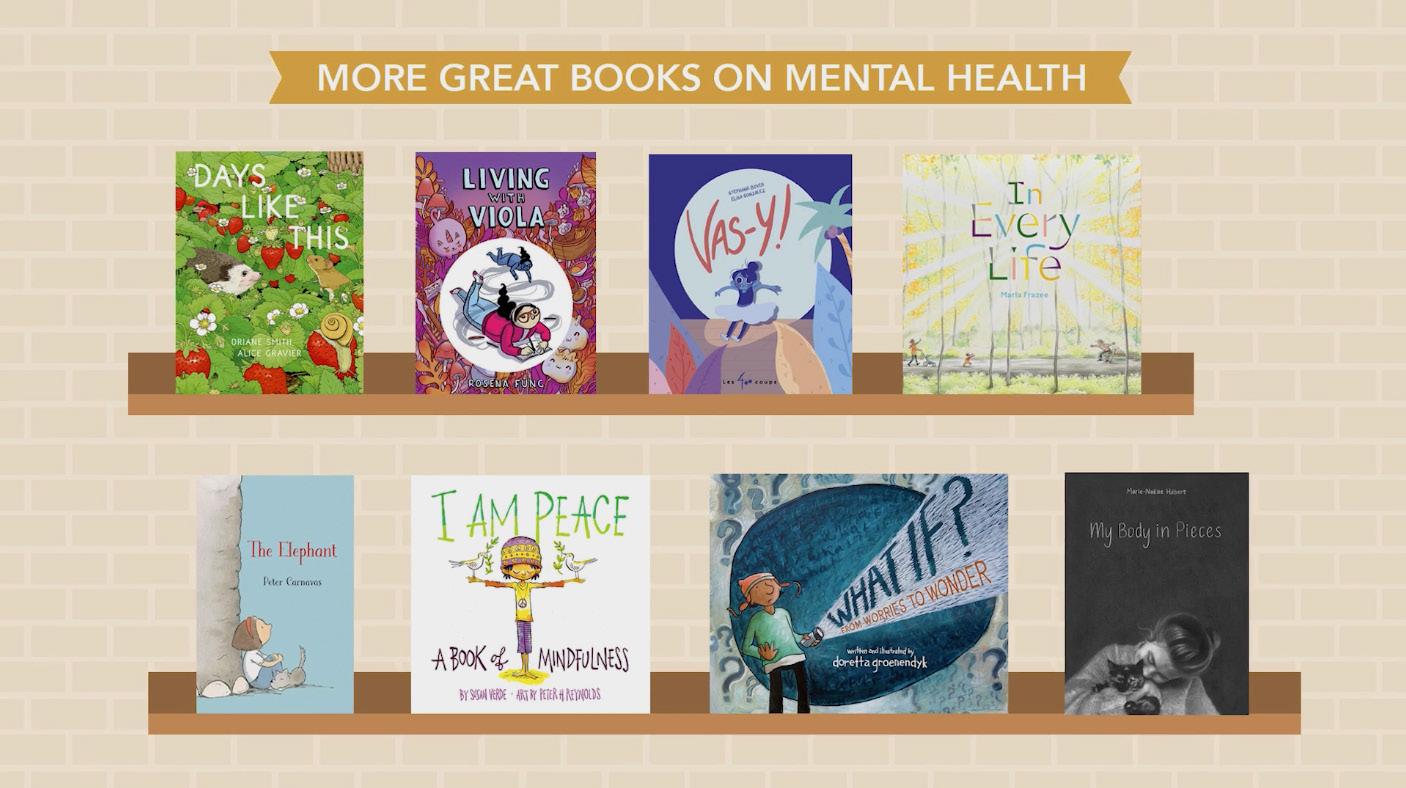




Did you know there are observances in Canada and the U.S. during the month of May that centre around communication? Speech and Hearing Month in Canada and National Speech-Hearing-Language Month in the States both recognize and raise awareness about the importance of communication health. To that end, we thought it would be fitting to focus this issue on the theme of communication—exploring the many different forms it can take and the impacts it can have.
Communication plays a huge role in all aspects of our daily lives, so it’s essential that children learn these skills from a young age. Speech language pathologist Laura Baukol is here to offer some advice on the subject. In her article, she shares five things that both students and teachers can to do be good communication partners. These tips can help students develop respect and empathy for their classmates, which ultimately leads to a more inclusive school environment. And what better time to practice than during Speech and Hearing (and Language) month?
There are different ways of communicating: verbally, non-verbally, written, etc. High school educator Paul Weatherford has figured out a fun and innovative way to incorporate many of these forms into his Creative Writing class: through the world of rap! Recently his students faced off against ChatGPT in an epic human vs. AI rap battle, where the class was tasked with “beating the machine” by composing positive rhymes about themselves and their school. Not only did this assignment give students a chance to boost their confidence and skills, it also demonstrated how writing can be used as a tool for empowerment and fostering hope.
As Weatherford demonstrates, good communication gives us the power to effect change. And in today’s tumultuous world, never has it been more important to effectively convey messages of optimism and inspiration. St. Bernard Catholic School is doing just that through their latest project: “BEE Hope.” As writer Fiona Tapp explains in her article, “The
Importance of Bees,” the school is building a pollinator meadow in their schoolyard to provide a safe space for bees and other pollinators. The article also includes a step-by-step guide to planting your very own school pollinator garden, and with World Bee Day coming up on May 20, now is the perfect time to get started! Not only are these gardens hugely beneficial for birds and insects, they can also serve as learning resources for students, teaching them about the crucial role of pollinators and helping to foster a deeper understanding of nature.
Today’s students are tomorrow’s leaders, which is why it is essential for the younger generations to develop an appreciation of the natural world and what must be done to protect it. Often the best way to learn about nature is to be immersed in it, which is why we’ve made a list of some incredible conservation areas that each offer environmental education programming. These trips are a great way to demonstrate the interconnectedness of all living things, as well as the incredible work that is being done to preserve local environments.
As we’ve mentioned, there are several notable observances taking place throughout the month of May. But another important date is right around the corner as well: Juneteenth. Marking the end of slavery in the United States, this holiday is a time to recognize African American freedom, resilience, and culture. For this issue’s Bookstuff, we have gathered a selection of books about the history of Juneteenth, as well as own-voice stories by Black authors who communicate the lived realities of Black people in America, both past and present.
Lastly, Curricula features another own-voice story—this one by Inuit author Serapio Ittusardjuat, who wrote about his experience of surviving on the sea ice after his snowmobile broke down. Through this lesson plan, students will learn the value of traditional skills and knowledge, as well as how to use a variety of methods to communicate with different audiences for different purposes.
See you next time.
KELSEY MCCALLUM ASSOCIATE EDITORThe Importance of Bees: Teaching Kids about Pollinators
Fiona Tapp COLUMNS
Bookstuff Juneteenth
Classroom Perspectives
That’s a Rap: Using Hip-Hop as a Tool for Learning
Paul Weatherford
16 Field Trips Conservation Areas
Teacher’s Pet
Classroom Perspectives
How to Be a Good Communication Partner
Laura Baukol
CURRICULA
Indigenous Voices: Inuit Culture, Lifestyle, and Traditions
Melanie Mulcaster
AD INDEX 27

CEO and Head Librarian, Shelburne Public Library 04 08 10 24 21 18 FEATURE
PUBLISHER AND EDITOR
Wili Liberman
MANAGING EDITOR
Lisa Tran
ASSOCIATE EDITORS
Kelsey McCallum
Raenu Sarathy
ASSISTANT EDITOR
Nupur Bagoria
CONTRIBUTORS
Laura Baukol
Melanie Mulcaster
Fiona Tapp
Paul Weatherford
ART DIRECTOR
Pauline Lopez
JUNIOR GRAPHIC DESIGNER
Amos Chin
EDITORIAL ADVISORY BOARD
Bernice Slotnick
Teacher (Retired)
John Myers
Curriculum Instructor, OISE (Retired)
Rose Dotten
TEACH is published by 1454119 Ontario Ltd. Printed in Canada. All rights reserved. Our contact info is: 1655 Dupont St., Suite 331, Toronto, ON, M6P 3T1 E: info@teachmag.com T: (416) 537-2103. For subscription info, visit shop.teachmag.com. Unsolicited articles, photographs and artwork submitted are welcome but TEACH cannot accept responsibility for their return. Contents of this publication may be reproduced for teachers’ use in individual classrooms without permission. Others may not reproduce contents in any way unless given express consent by TEACH. Although every precaution is taken to ensure accuracy, TEACH, or any of its affiliates, cannot assume responsibility for the content, errors or opinions expressed in the articles or advertisements and hereby disclaim any liability to any party for any damages whatsoever. Canadian publication mail sales product agreement No. 43579512. ISSN No. 1198-7707.

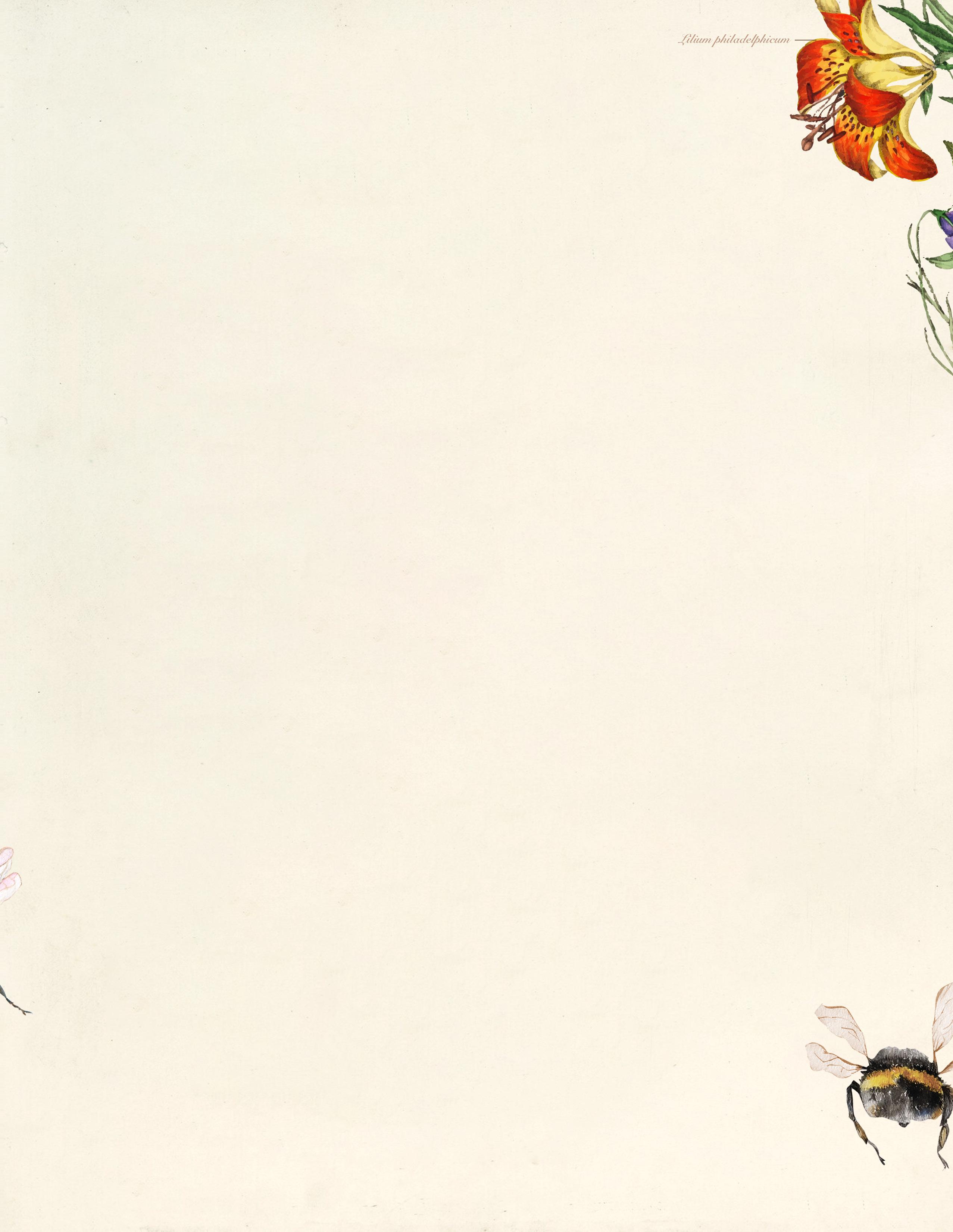
The humble bee is a symbol of busy productivity. It is also one of the most important pollinators. What makes bees so special? They transfer pollen from male to female flower parts in order to fertilize plants, a process that is essential for the reproduction of many flowering plants, including fruits, vegetables, nuts, and seeds. Bees and other pollinators are responsible for 35 percent of global crop production. Without them the resulting imbalance in our agricultural system would severely threaten food supplies.
Bees also contribute to soil fertility, plant diversity, and nutrient cycling, playing a vital role in maintaining healthy ecosystems. There are over 800 species of native bees in Canada and one in four species are at risk of extinction. If they disappear our planet would suffer, exacerbating environmental degradation and making ecosystems more vulnerable to other stressors, such as climate change and habitat loss.
In a broader sense, bees act as barometers of the planet’s overall health. Their sensitivity to changes in habitat, climate, and pesticide exposure makes them valuable indicators of broader environmental trends. Monitoring bee populations can provide insights into the impacts of human activities on ecosystems and help inform conservation and management efforts.
It’s about time bees got the proper respect they deserve, and at one elementary school in Ottawa, they will soon have an entire pollinator meadow dedicated to them.
Teachers at St. Bernard Catholic School have been busy collaborating on a new project called “BEE Hope,” which aims to create a naturalized, bee-friendly area within the schoolyard. It will feature flowers, trees, and shrubs to attract bees and other pollinators, and will be used as a practical learning resource for students.
The idea started as a school-wide art project in collaboration with Canadian artist Maria Saracino, who works with polymer clay and textiles. For the project, every child from kindergarten to Grade 6, along with their teachers, created their own hexagonal polymer clay tiles featuring symbols of Canada. Now those tiles will become part of the garden design.
As the teachers researched different ideas and topics to inspire students, they discovered that Saint Bernard, for whom the school is named, is actually the patron saint of beekeepers. This got everyone thinking about bees and their habitat, and
eventually staff and students came up with the idea of making a pollinator garden to help support the bees.

Saint Bernard’s patronage comes as no surprise to Oliver Couto who, besides being a beekeeper and owner of the Toronto-based The Bee Shop, is also a philosophical and religious scholar. Couto describes the honeybee as “the apex of evolution” and has been exploring the spiritual side of the insect through his film series, The Sacred Bee.
The Bee Shop hosts an introductory beekeeping course, as well as a Young Beekeepers Club—an after-school program for children aged 8 to 14 years. “Each month we cover various aspects or facets of beekeeping,” Couto says. “Then they get involved with planting a seed in our rooftop pollinator garden.”
Couto also makes educational visits to daycares and schools to teach kids about the importance of bees. “Our most popular activity is beeswax candle making,” he notes. The activity gives students a chance to make their own mini candles, which they get to keep.
Additional educational activities include “honeybee vision,” where students learn about how honeybees can see in ultraviolet. “That’s pretty amazing,” Couto says. “We also have a pollination activity where we teach [kids] how the honeybees help ensure our nation’s food supply.”

Maria Fabiani has been a teacher for 25 years, and has taught at St. Bernard for the last four. She says it felt like kismet that, in creating a pollinator garden, herself and the school’s other educators were able to draw so many connections with cross-curriculum topics and links in the Ontario science curriculum, including the Life Systems strand.
Many of the polymer clay tiles that will decorate the bee garden feature designs of native animal species. This prompted teachers to connect with the school board’s Indigenous Education Consultants to ask them for advice and guidance regarding plants that are indigenous to the area. They also inquired about any special considerations that should be made to honour Traditional Knowledge and teachings.
Alanna Trines, Indigenous Education Lead at the Ottawa Catholic School Board, has been a teacher since 2007. Her Indigenous Education Team supports teachers with Indigenous education, aiding in presentations, lesson planning, and clarifying Indigenous concepts like land acknowledgments. They manage ministry funding, tackle resistance to Indigenous initiatives, and assist Indigenous students and families by removing barriers and providing support.
Trines says that her team is always happy to hear from teachers looking to incorporate indigeneity into school plans and resources, but that it’s important to keep a few guidelines in mind to avoid tokenism or cultural appropriation.
“The four sacred medicines are Tobacco, Cedar, Sweetgrass, and Sage
and a lot of folks want to plant them in healing gardens or medicine gardens, but these are sacred medicines for Indigenous communities,” she explains. “Just planting them to have them there is a beautiful gesture, but without collaborating with community to provide the appropriate teachings of the sacredness of those medicines, then we’re not really doing the good work yet.”
Collaboration among teachers, parents, community leaders, and Elders is essential. “Nothing in Indigenous education should be done alone or in a silo,” Trines says. “Everything should be done from a collaborative approach.”
St. Bernard school’s plan to open the garden by the end of the academic year is a good example of a collaborative community project in action.
As Fabiani explains, “We’re all working on different parts of this as it has become a very big project. We need a contractor to dig out the area in the schoolyard and we’re looking at getting parent volunteers and volunteers from the community to help water the garden over the summer holidays. We’re hoping that Father Eslin at the church next door will come and bless the garden. It’s truly become an all-encompassing project.”
The school is so committed to teaching kids about the importance of bees that it’s taking the initiative to the next level by incorporating the bee into its very own identity. St. Bernard has plans for a new bee school mascot, as well as bee-themed t-shirts for staff. The project’s name, “BEE Hope,” is even connected to the school board’s overarching strategic commitment to “Be Hope,” which includes teachings on gratitude, joy, and hope.
“We’re creating this community for the bees, and the flora and fauna, but in a deeper sense, we’re creating a stronger community for our students and our staff,” Fabiani says.
Learning more about bees goes far beyond sustainability. These industrious insects have strong community bonds and can show us the importance of teamwork, communication, and collective effort in achieving our common goals.
Teaching students about bees also helps foster a deeper understanding and appreciation of nature, instilling a sense of environmental stewardship. Plus, interacting with a pollinator garden gives kids hands-on experiences observing


pollination in action, allowing them to develop important scientific inquiry skills and gain insights into the interconnectedness of ecosystems.
FIONA TAPP is a former teacher and school administrator of 13 years. She writes about education, parenting, and travel for a variety of publications including National Geographic, the Globe and Mail, the Toronto Star, the Sunday Times, and many more.

✤ Educational resources from the Ontario Beekeepers’ Association
✤ An online exhibition about bees from the Canada Agriculture and Food Museum
Empower your class to become responsible and environmentally conscious citizens with their own bee-friendly garden. Here’s a step-by-step guide to help get you started:
Choose an appropriate location for your pollinator meadow. Look for an area with plenty of sunlight, good soil drainage, and enough space to support a variety of wildflowers and grasses.
Research native plant species that are attractive to pollinators in your region. Native plants are welladapted to the local climate and soil conditions, making them ideal choices for your meadow or garden. These Canadian plants help attract pollinators like bees:
✤ Black-eyed Susan
✤ Canada goldenrod
✤ Purple-stemmed aster
✤ Swamp milkweed
✤ Wild bergamot
✤ Wild strawberry
Design your meadow layout, considering factors such as plant height, bloom times, and colour variety. Aim for a diverse mix of flowers, grasses, and other vegetation to attract a wide range of pollinators.
Prepare the soil by removing any existing vegetation and weeds. Loosen the soil to a depth of several inches to promote root growth and water infiltration.
Plant your selected native plants according to your design plan. Follow the recommended spacing and planting depth for each species. Water the plants thoroughly after planting to help them establish roots.
MAINTENANCE
Maintain your pollinator meadow by watering as needed, removing weeds, and monitoring for pests or diseases. Involve students and teachers in ongoing maintenance tasks to foster a sense of ownership and stewardship.
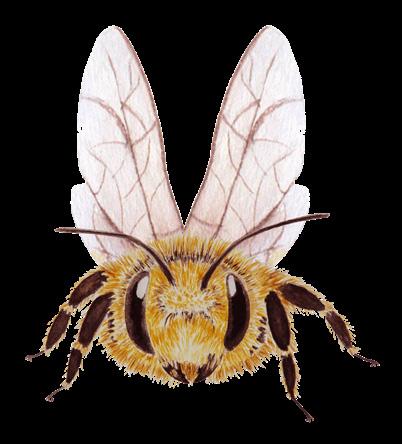
EDUCATIONAL
Use the pollinator meadow as an educational resource for students. Incorporate lessons on ecology, biodiversity, and the importance of pollinators into your curriculum. Encourage students to observe and document the plant and insect life in the meadow.
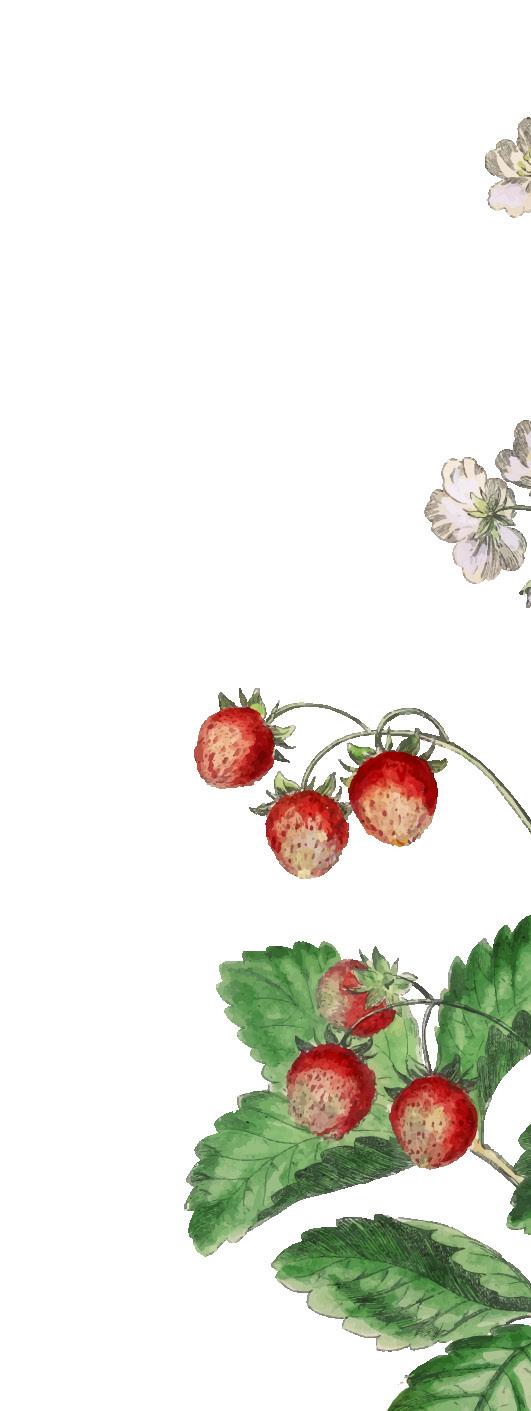

uneteenth commemorates the end of slavery in the United States. On June 19, 1865, the last enslaved people in Texas were emancipated. Over 150 years later in 2021, Juneteenth was established as an official federal holiday in the U.S., although it has been observed in Texas and other states since 1866. It is a time to recognize African American freedom, achievement, resilience, and culture, while also acknowledging the work towards equality that is still ongoing today. As you and your students get ready to celebrate this important holiday, here are some recently-released books to help you learn more about the history of Juneteenth and the lived realities of Black people in America, both past and present.

 BY KIM JOHNSON
BY KIM JOHNSON
Kokila (February 2024)
Grade Level: 7-12
In this semi-autobiographical poetry collection, award-winning author Renée Watson presents a celebration of Black girlhood. Through haiku, free verse, and a variety of other poetic forms, Watson shares her experience of growing up as a young Black girl in Portland. Her book also includes poetic odes to the Black women in her life, along with calls to action for other Black girls, urging them to embrace their own futures. The book is accompanied by an educator’s guide.
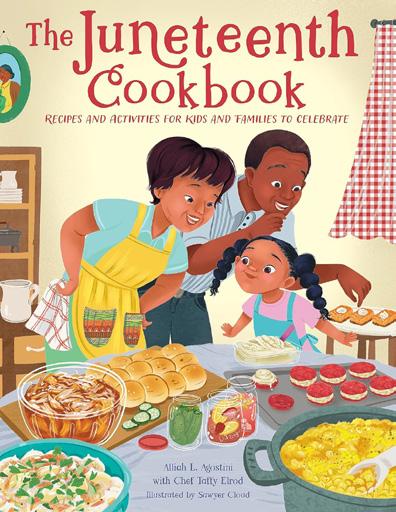
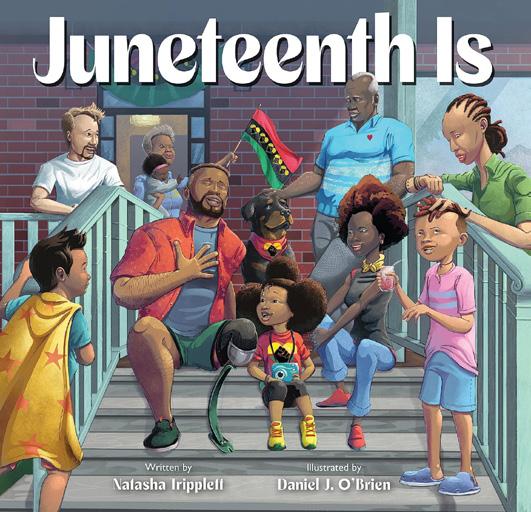 ALLIAH L. AGOSTINI
ALLIAH L. AGOSTINI
Random House Books for Young Readers (June 2024)
Grade Level: 7-12
Set in 1955, this social justice thriller follows a Black family as they move to a “Whites Only” suburb. There they spend their days passing as white, but for teenage Calvin, hiding his true self is easier said than done. And when he uncovers dark secrets about the suburb and the people who live there, the town becomes more dangerous than he could’ve ever imagined. Based around real historical events, acclaimed author Kim Johnson shines a light on issues faced by Black people in America 70 years ago and still to this day.
becker&mayer! kids (April 2024)
Grade Level: 3-6
This charming, brightly illustrated cookbook contains 18 easy recipes for popular Juneteenth dishes. From potato salad to chicken sliders to red velvet ice cream sandwiches, kids are sure to have a blast crafting these delicious foods. They’ll also learn about the historical origins of barbeque and how it relates to Juneteenth and Black culture. The Juneteenth Cookbook even includes five activity sections: kids can design their own Juneteenth outfit, play mancala, join in virtual Juneteenth celebrations across America, and more!
1 BLACK GIRL YOU ARE ATLAS BY RENÉE WATSON, ILLUSTRATED BY EKUA HOLMES 2 THE COLOR OF A LIE 3 THE JUNETEENTH COOKBOOK BY4 JUNETEENTH IS BY NATASHA TRIPPLETT, ILLUSTRATED BY
DANIEL J. O’BRIENChronicle Books (April 2024)
Grade Level: K-3
This picture book is a tribute to the history of Black communities in the United States. It tells the story of family and community, while commemorating a past of struggle and resilience. Through a combination of intimate text and warm illustrations, Natasha Tripplett and Daniel J. O’Brien show readers that Juneteenth is more than just a holiday, it is a cultural legacy. Their book also serves as an important reminder for all of us that Black history is American history.
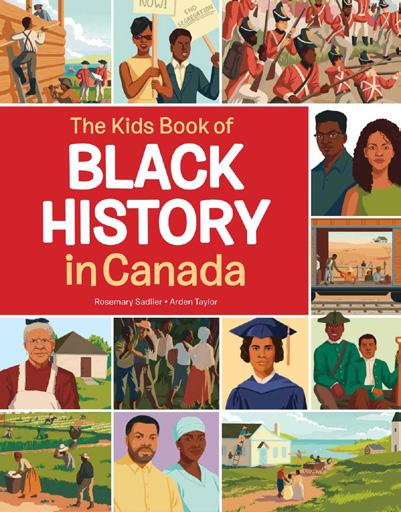
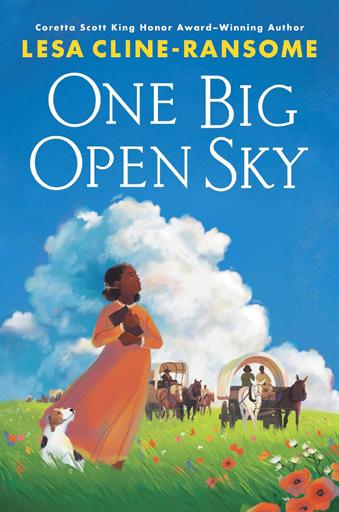
6
Holiday House (March 2024)
Grade Level: 3-7
Award-winning author Lesa Cline-Ransome explores the underrepresented history of the Black homesteader movement and the theme of Black self-emancipation through this intergenerational novel-in-verse. Following the end of the Civil War and slavery, three women are making their way west towards Nebraska to claim their very own plot of land. Although they have recently been freed from slavery, the women are still bound by poverty, and it is their hope that this new opportunity will offer them the chance to finally claim their independence.
5 THE KIDS BOOK OF BLACK HISTORY IN CANADA
BY ROSEMARY SADLIER, ILLUSTRATED BY ARDEN TAYLORKids Can Press (June 2024)
Grade Level: 3-7
Although Juneteenth is not officially celebrated in Canada, it can serve as an occasion to continue educating ourselves about Black history across North America. This book takes readers on a narrative journey beginning in 1604 with the arrival of the first known African in Canada—Mathieu Da Costa—and continues through to the fights for social justice that are still ongoing today. It includes stories of Black Canadians across all moments in history, as well as sidebars of facts, quotations, and profiles of important Black figures.

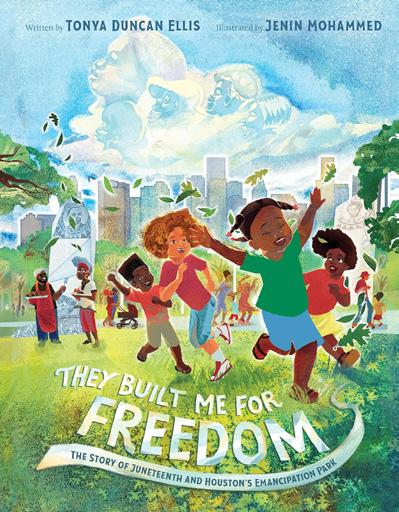
7 POEMHOOD: OUR BLACK REVIVAL
EDITED BY AMBER MCBRIDE, TAYLOR BYAS, AND ERICA MARTIN
Harper Teen (January 2024)
Grade Level: 8-12
Featuring 37 voices, this YA anthology of Black poetry considers the question: What exactly is it to be Black in America? These poems showcase the diversity of the Black experience, while paying homage to Black culture and folklore. Classics by poets like Audre Lorde and Gwendolyn Brooks are presented alongside contemporary material from poets such as Kwame Alexander and Ibi Zoboi, showcasing the rich history of Black poetry across generations. Each poem is followed by a brief explanation to make it more accessible to readers.
8 THEY BUILT ME FOR FREEDOM BY TONYA DUNCAN ELLIS, ILLUSTRATED BY JENIN MOHAMMED
Balzer + Bray (May 2024)
Grade Level: K-3
Young readers can learn more about the origins of Juneteenth through this picture book. It shares the story of Emancipation Park, a park in Houston, TX, that was created to commemorate the end of slavery on June 19, 1865. Told through the voice and memory of the park itself, They Built Me for Freedom presents an ode to the courage and triumphs of Black America, while also serving as a promise to remember.
ONE BIG OPEN SKY BY LESA CLINE-RANSOME
Sometimes people ask (and I occasionally ask myself),
“Why in the world do you teach?
Why bother with those kids, who are so hard to reach?
Couldn’t you be making real money and own a home by the beach?
Why do you accept a plate full enough to make anybody screech?
For that matter, why would any sane person step into

There are a few screws loose in this brain, Yet, to me, the truth could not be more plain.
type of gain—
I remain a teacher daily
Knowing that it’s bound to bring me pain, Yet, I still show up to teach,
Because I know of no other domain, That matters so dearly, that courses through the world’s vein.
For what we do, as educators, with our every labored breath, Boils down to this—our work is a matter of life and death.
 By Paul Weatherford
By Paul Weatherford

That’s a heavy load to carry, and we’ve done it so well,
We’re the ones who see this challenge, and our hearts begin to swell.
We’re the ones who treasure knowledge, ‘cause we were changed under its spell.
So, I dedicate this rap right now to all of us who care,
Who are ready to respond to the shifting winds in the air.
It’s time to rise up, to unearth the fire in our schools.
Through deliberate decisions, we’ll create a new set of tools.
In our everyday actions, we can rewrite the rules.
So, let’s light this new flame, inviting everybody in,
To celebrate, to experience, to put on a grin.
That’s what builds culture and makes learning lifelong,
That’s true engagement, and that will always be my song.
For it’s this that we must remember, and this that counts most,
To share in life together, must remain our purpose foremost.
I, among other things, define myself as a rapper, and it’s a fact of which my students are all too aware—“Is he really rapping on the first day of school?” I use raps to hook my readers (did it work?), to bring literary characters to life, to commemorate momentous occasions, and, most of all, to inject the world inside and outside of the classroom with a bit of the extraordinary.
Each day that I teach at South High School, I walk into a building that the state department of education deems “failing,” and yet within those walls, I encounter many moments that sing of success, especially in my Creative Writing class. A recent activity that I came up with helped bring hope, community, confidence, and critical thinking to the students. I turned to my good ol’ friend hip-hop to accompany me on this journey and, as it always does, hip-hop brought us together, enhanced our own unique voices, and allowed us to have some fun.
The first lesson I gave my students in rap was to study and imitate the art of bragging. After analyzing some mentor texts, I challenged them to boast about themselves using figurative language and rhyme. They were quite hesitant to do so, not because of a skill deficit in writing, but rather a deficit in their own self-worth.
“But I’m not that great, Mr. Weatherford.”
“I’m not special.”
“I’m not a rapper.”
I thought I’d inject a little competition to see if I could scare up more excitement and creativity. “Next class,” I said, “we will be pairing our best rhymes anonymously for a rap battle.” Nothing like the pressure of an audience to produce results. The students quickly got to work and cooked up some solid lines.
Little did they know that I also gathered several verses from one of the meanest MCs on the Internet: ChatGPT. It’s quite unnerving to see the screen produce a full-blown rap song, a decent one no less, in under 10 seconds. From there,
I paired a student-written line with an AI-generated one, and during our next class, students voted on which was better. They also shared their reasons why, as a way to get them thinking about some of the tools and tricks that authors (and robots) use.
Four out of five times, students picked the AI rhymes over the ones from their own classmates. They even picked AI over my own writing, which tempted me to fail them all right then and there. But rather than taking it personally, we decided to use this as a learning experience.
This exercise underscored what I had told students all semester long—at its core, good writing is imitation. For how does AI operate? It reads and analyzes exemplars, effectively imitating and implementing their tricks and tools. This is a practice my Creative Writing class engages in daily.
The AI rap battle also captured the other thing I always say about writing—imitation is only the starting point. Truly great writers do new things, inventive things, and most of all, they put their very selves into every line on the page. AI can’t do that… yet.
I wanted to give my students another chance to battle it out against AI in the rap arena, but this time I changed the nature of the contest. Rather than bragging about themselves, they would need to write rhymes that bragged on South High. Surely, we could outperform AI on this subject.
Students at South High School are all too aware of the many negative narratives surrounding our school, and class discussion confirmed this. When asked to list words that describe South, they said, “Ghetto, bad, druggy, dumb, and poor,” to name a few. I pressed them, wondering, “Are these your words, or are they words that others use to describe our school?”
That question stumped them for a second and, upon deeper reflection, the students recognized how the words of others had come to color their own perceptions of the school. They had also experienced South High as, “Supportive, fun, and a home.” I capitalized on
these positive descriptors, letting the students know that now they were in the right state of mind to get into a rap.
After our first round of typing “braggy” rhymes, I decided to inject a little artificial intelligence into the equation once again. We were all slightly disheartened to see ChatGPT cook up a full-blown rap about our school with verses, a chorus, and a bridge in approximately 20 seconds. No less than that, it also made specific references to the windy nature of our state, our school mascot, and our colors.
The look on my students’ faces contained a question: “Why should we bother to write when AI can do this?” Luckily, there was another expression to be read there, a determination to beat the machine.
And beat the machine they did! While crafting their rhymes, the students had maintained, “We can’t just ignore the ‘bad’ stuff that happens at our school.”
To my surprise, they found a way to incorporate those negative aspects, weaving their verses with authenticity and heart that was missing from the AIgenerated rap.
Whether it was Sarah’s clever use of our feeder junior high mascot, the firebird, to talk about students rising from the ashes and evolving through their educational journeys; or Zack’s shrewd observation that rainbows and butterflies are an illusion, and South can take pride in keeping it real; or Elisa, who coined South as a perfectly imperfect institution. In the students’ lines I felt pride and I saw success, the growth of confidence and skill, and most important of all, young people making meaning of the world they know and the worlds they dream of. What a gift it is to witness something like that.
Our so-called ghetto, bad, druggy, dumpy, and poor school made the news several times in the last year alone: for our students’ outstanding charity work, for our championship cheer team, for the death of a beloved student killed in a reckless driving accident, and for a
tragic incident of student violence. While these stories work to define us, so too do the brilliant rhymes produced by my Creative Writing class, although the chance of them making headlines is slimmer.

Over the course of one single class period, one school day, and across one school year, we educators bear witness to a full spectrum of experiences. From that mesmerizing moment when a learner finds their voice, to seconds later, when a student refuses to engage in pleasantries, let alone learning. It is enough to make any brain bend.
To add to the dilemma, the collective sentiment of educators indicates that this job is only getting harder. There’s no denying that we face unprecedented challenges. You need merely glance at the news to see a weary world troubled by seemingly goliath calamities. But as is often the case amid such turmoil, the cure is good teachers—those who hold, produce, and share hope.
I firmly believe that writing is the best tool we have to foster this hope. My goal as a teacher is to expose students to a variety of voices, styles, and frames for writing so that they can properly identify where they belong—so they can create a playground of their own, and do the necessary work of excavation. And most importantly, by teaching students to wield writing as a tool, we can empower them to compose their own narratives, fight against prejudice, and change the world. That’s true engagement, and that will always be my song… or rather, my rap.
*Student names have been changed.
PAUL WEATHERFORD has taught at all levels from 7-12 over the past 10 years. In addition to completing a Master’s degree in English Literature, he recently won Teacher of the Year for Laramie County School District #1, and was a TOY finalist for the state of Wyoming. Inspiring students to see the magic of words is his life’s work, second only to being a husband and father.
Hip-hop’s a nifty tool, When I was lost, it’s what I found. Picked it up, thought it was cool, My heart was no longer bound, But rather bounding Up and down, Boppin’ all around. I always keep it poppin’, You know there ain’t no stoppin’
When a tasty beat gets droppin’, I’m all set to rock, ready to resume. I’ll be makin’ lines from this day ‘til I reach the tomb. That’s why when you step into my room, You see a writer’s lair, And you can almost feel it, That magic’s in the air, It’s a confounding mystery, something you can’t describe. The way these words wield powers. If you want this feelin’, and this vibe, Come join us in this tribe, Where we don’t count the hours. We count lines and syllables, And write about our lives. We don’t worry about the haters, Brandishing their knives. Our words are our strength, And they go to any length, To reveal the truth about existence, That in this language we employ, We find subsistence, Persistence, The ability to go the distance.





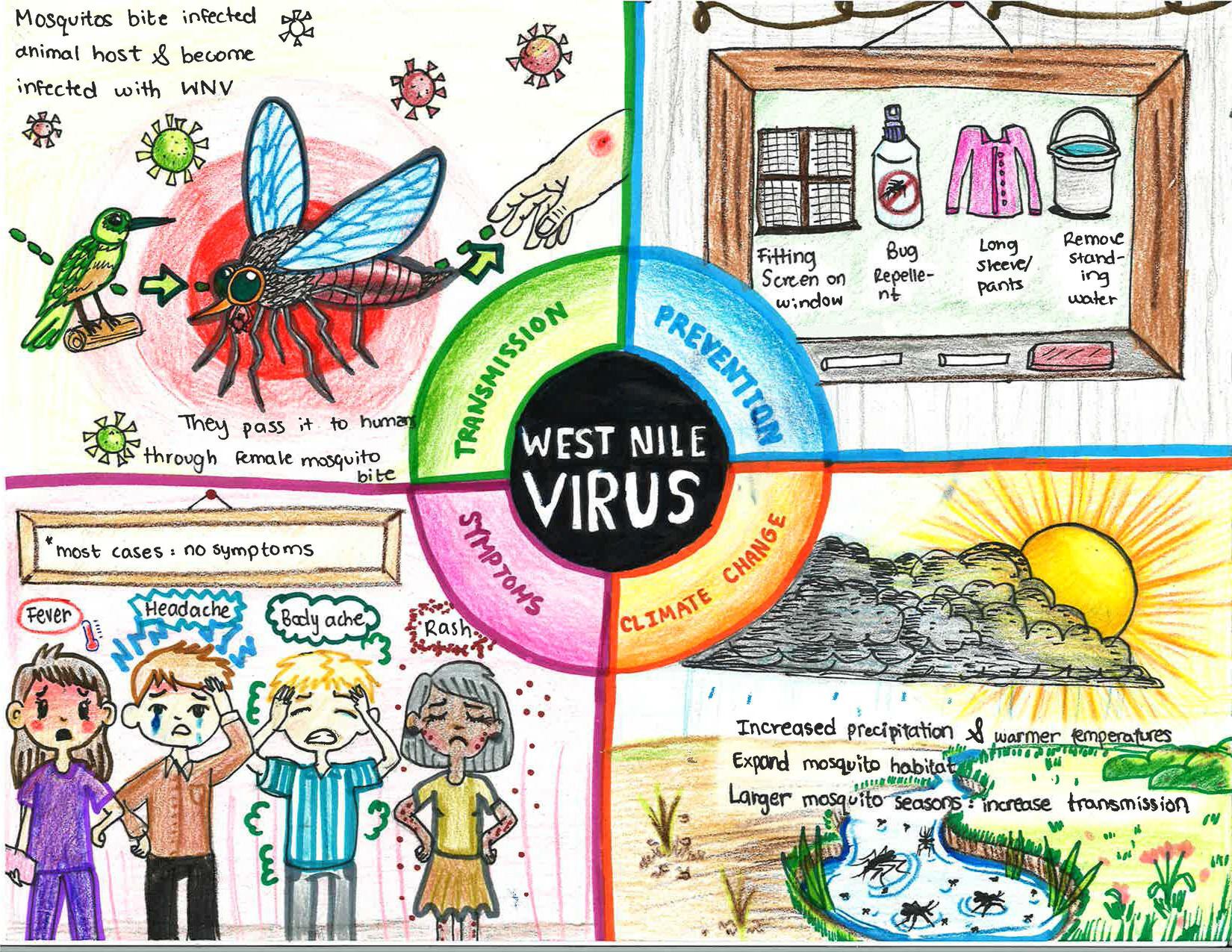



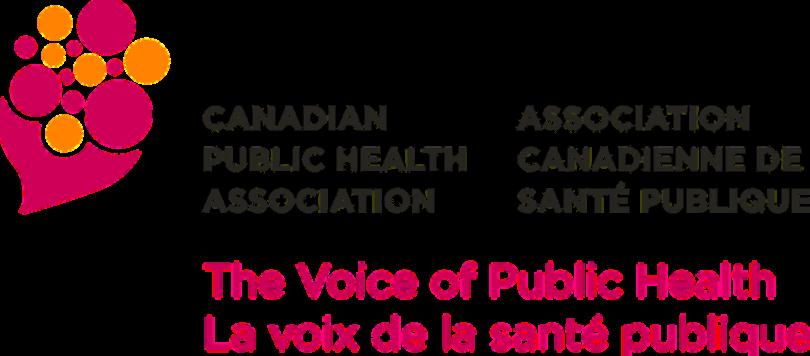
Engaging with the outdoors at a young age allows children to form a lasting bond with nature, while also learning about the responsibility of protecting and sustaining it. So, we’ve made a list of some incredible conservation areas that offer environmental education programming. Through conducting field surveys, following animal tracks, identifying trees, and more, these trips will inspire students to care about the flora and fauna around them, while encouraging them embrace their role as environmental stewards of the future.
Foothills, AB
ASCCA’s outdoor programs offer a unique and immersive way to supplement your students’ learning about the interconnectedness of all living things. Kids from Grades 1-9 can explore this 4,800-acre living classroom while taking part in a wide range of hands-on, curriculum-connected topics. From the fascinating lifecycles of insects, to the incredible ways plants and animals survive in winter, to the important role trees play in mitigating the effects of climate change, students will gain a deeper understanding of biodiversity, stewardship, and how all species (including humans) fit into the web of life.
Blue Hill Peninsula, ME
Field trips along the Blue Hill Peninsula cover a diverse range of ecological topics including local geology, vernal pool ecosystems, fire safety, and native plants. The Trust also connects teachers with experts and professionals in the community to lead field trips on various subjects like mushrooms, birding, seaweed, and nature journaling. Teachers are encouraged to share their requirements for standards and curriculum connections so that each trip can be customized to suit their needs.
Various locations, ON
CLOCA offers year-round educational opportunities for K-12 students to learn about watersheds, conservation, and the natural world. Choose from dozens of curriculum-connected programs, all of which are designed to help students explore habitats and gain knowledge about biodiversity, while also engaging in interactive games and activities. A selection of virtual field trips are available as well, and be sure to check out the additional teacher resources.
ANN & SANDY CROSS CONSERVATION AREA BLUE HILL HERITAGE TRUST CENTRAL LAKE ONTARIO CONSERVATION AUTHORITYVarious locations, IL
The Conservation Foundation runs K-12 field trips at their two farms sites in Naperville and Montgomery, but they will also lead a field trip exploration at any local natural area, or even bring hands-on environmental education programs right to your classroom! Choose from curriculum-aligned field trips about geoscience, decomposers, wind and solar power, and more.
Toronto, ON
Located in Toronto’s largest public park, this nature centre is an excellent destination for educators who want to provide their students with an unforgettable learning experience. Here, K-12 students will engage in a variety of hands-on activities that help them understand the ecosystems of High Park, the importance of its soil and water bodies, and the history of the land. Each half-day field trip includes a hike, games, and stimulating discussions that foster curiosity and critical thinking.
Calgary, AB
In collaboration with the Nature Conservancy of Canada, Inside Education has created a selection of half-day, hands-on field programs for junior high students. At the unique Three Herons site, students will have the opportunity to perform assessments for terrestrial and aquatic ecosystems, while also exploring the connections between wildlife, water, and land use. This is a fantastic opportunity to learn about the environment and contribute to its preservation!
Regina, SK
Students can get their fill of nature right in the heart of the city at Wascana’s Habitat Conservation Area. This 23-acre site is home to many notable plant and animal species who are featured in the centre’s one- to three-hour programs. Elementary students can learn about wetlands, plant and animal adaptations, outdoor survival skills, and more, while older students have the chance to gain field experience by conducting their own biodiversity surveys.
VIRTUAL FIELD TRIPS/RESOURCES:
• The Nature Conservancy
• Natural Resources Foundation of Wisconsin
• Niagara Peninsula Conservation
• Lynn Canyon Ecology Centre
GRADE LEVEL:
JUNIOR (4-6)
THEME: INDIGENOUS VOICES
SUB-THEME: INDIGENOUS HERITAGE AND CULTURES, FAMILIES, IDENTITY/SELF-ESTEEM/ CONFIDENCE, SURVIVAL
HEAT ENERGY AND CONSERVATION


LEARNING FOCUS

In this learning experience students will:
• Learn from a wide variety and range of media texts from diverse cultures
• Learn how to understand texts by connecting the ideas in them to our own knowledge, experience and insights, to other familiar texts, and to the world around us
• Learn to assess the benefits of technologies and strategies that reduce heat loss in the arctic
• Learn to use a variety of forms (e.g. oral, written, graphic, multimedia) to communicate with different audiences and for a variety of purposes
MINDS ON PROVOCATION
Use copyright-friendly resources such as Pixabay, Unsplash, or Pics4Learning to find an image of the Canadian Arctic.

Begin by asking students to use one word to describe the environment shown. Responses can be collected on sticky notes and posted to a whiteboard/blackboard, or collected using virtual tools like Jamboard or Padlet.
Pose these questions to the class: If you were stranded in this environment for four days, what would be your biggest concern to ensure survival against the elements? More importantly, what would you need in order to survive?
After students have finished brainstorming, ask: How might you rank the list of items from most important to least? (More information on how to use a ranking ladder as an instructional strategy can be accessed here.)
Before Reading:
Have students explore the “Before Reading” section of the linked choice grid for How I Survived: Four Nights on the Ice
Before actually reading the text, ask students to make predictions about the title. What might the author have done in order to survive four nights on the ice?
During Reading:
If possible, share the story using a document camera for better viewing.
As the text is being read aloud, pause the story at key points where the author discloses strategies he used in order to keep himself warm and alive. Record strategies on a physical or virtual document.
Have students additionally record any questions, terms, or references that they may be unfamiliar with for further research.
After Reading:
As a group, what questions about the reading arose? Curate class thinking on a document.
As a class, review strategies the author used to survive. How might they be ranked in terms of which were most effective for his survival?
Have students explore the “After Reading - Additional Research” section of the choice grid to help answer any inquiries they might have. What other research might students find to add to the choice grid in order to extend the inquiry?
How might you survive four nights on the ice?
Students are encouraged to create a promotional or public service text that explains how they or others might survive four nights on the ice.
Options could include: sketchnote or infographic, poem or dramatic presentation, slide presentation, video presentation, audio podcast/song or recording. Here are some Creative Tools for Making and Sharing for more ideas.
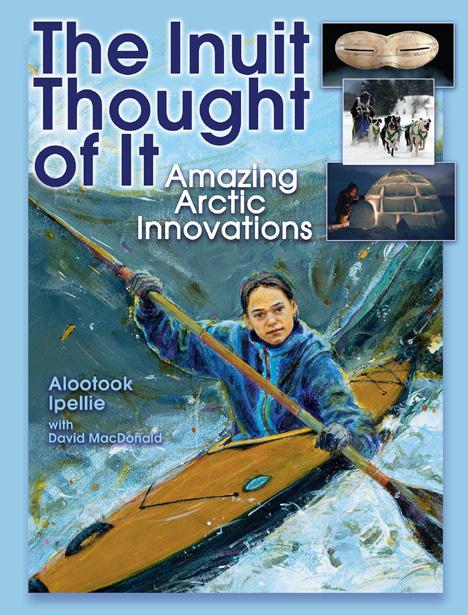

 The Inuit Thought of It: Amazing Arctic Innovations by Alootook Ipellie and David MacDonald (Annick Press, 2007)
The Inuit Thought of It: Amazing Arctic Innovations by Alootook Ipellie and David MacDonald (Annick Press, 2007)
• What did you find interesting about this learning? Have you changed any ideas you used to have on this subject?
• What questions or connections might you still have?
• What is one thing you want people to notice or know about your learning artifact?
• How and where else might this learning be amplified? Who else could benefit from this learning?

• Inuit Book List (Concordia University of Edmonton)
• 20 books to read for Nunavut’s 20th anniversary (CBC Books)
This learning experience could be adapted for use in online learning environments. Use virtual collaborative tools to curate and collate thinking (i.e. Jamboard, Google Docs and Slides). The choice grid was created using Google Slides. For more information on how to create choice grids, please see the linked YouTube playlist (credit: Tina Zita, TeacherLibrarian, Aylesbury Public School).
• Ranking ladder template
• “Who Are the Inuit?” (Elementary Teachers’ Federation of Ontario, 2021)
• “Making Read-Alouds Purposeful” (Canadian School Libraries Journal, 2020) – Deborah McCallum discusses the potential of designing learning experiences to connect informational texts with narrative texts to build content knowledge and vocabulary in authentic and engaging ways.
If you’d like your furry or feathered friend to be featured, visit our website and check the submission guidelines.
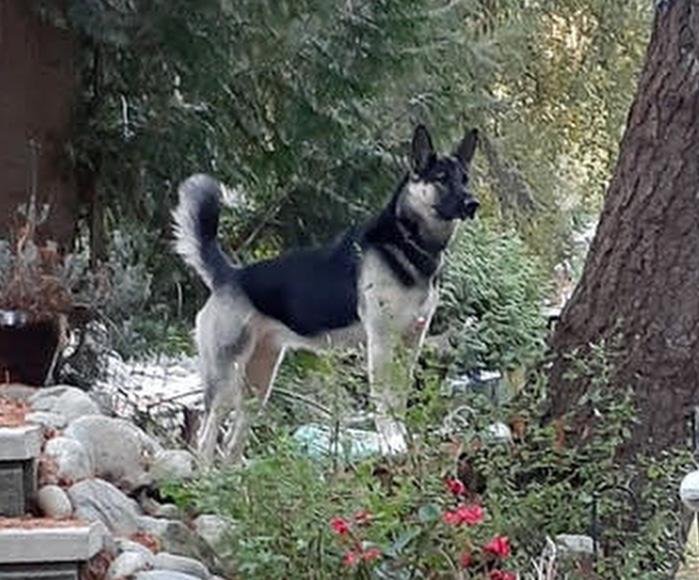
Dakota | 4y | Northern Special (Husky/Shepherd Cross)
Location: British Columbia, Canada
Parent: Shirley B.
Energetic, Intelligent, Loving

Luna | 8y | Papillon/Chihuahua Mix
Location: North Carolina, USA
Parent: Eric G.
Big Scary Wolf, Family Protector

The Great Grey Ooblek 2y | Domestic Long Hair
Gandy Fluffyjammiepants
9y | Norwegian Forest/Tabby Cross
Location: British Columbia, Canada | Parent: Holly C.
Devoted, In Love, Nice
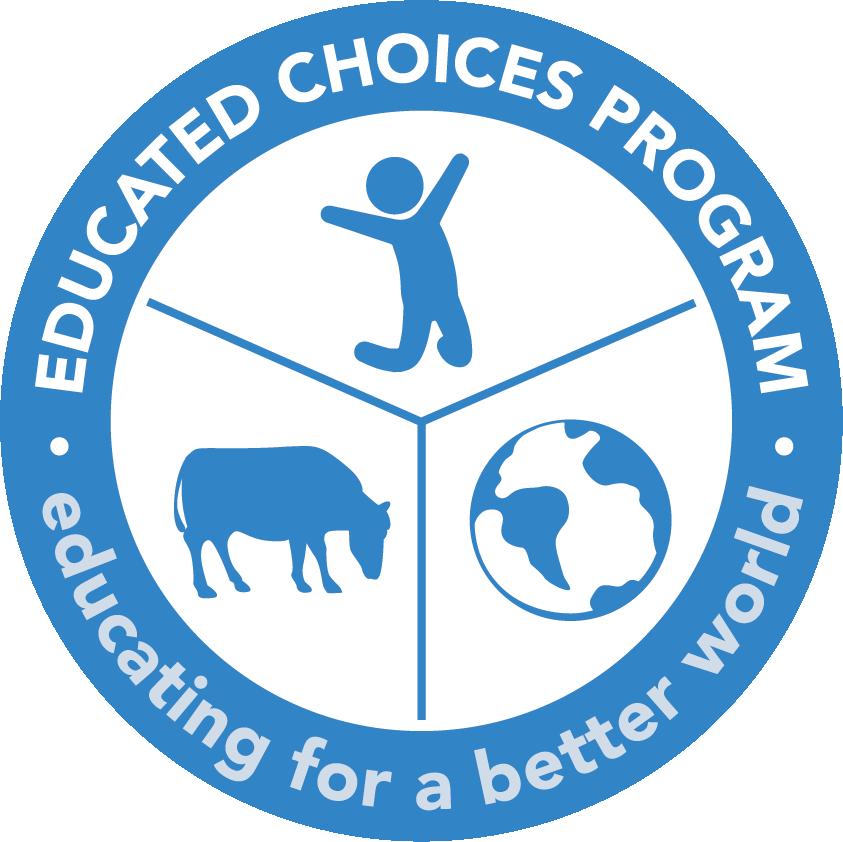
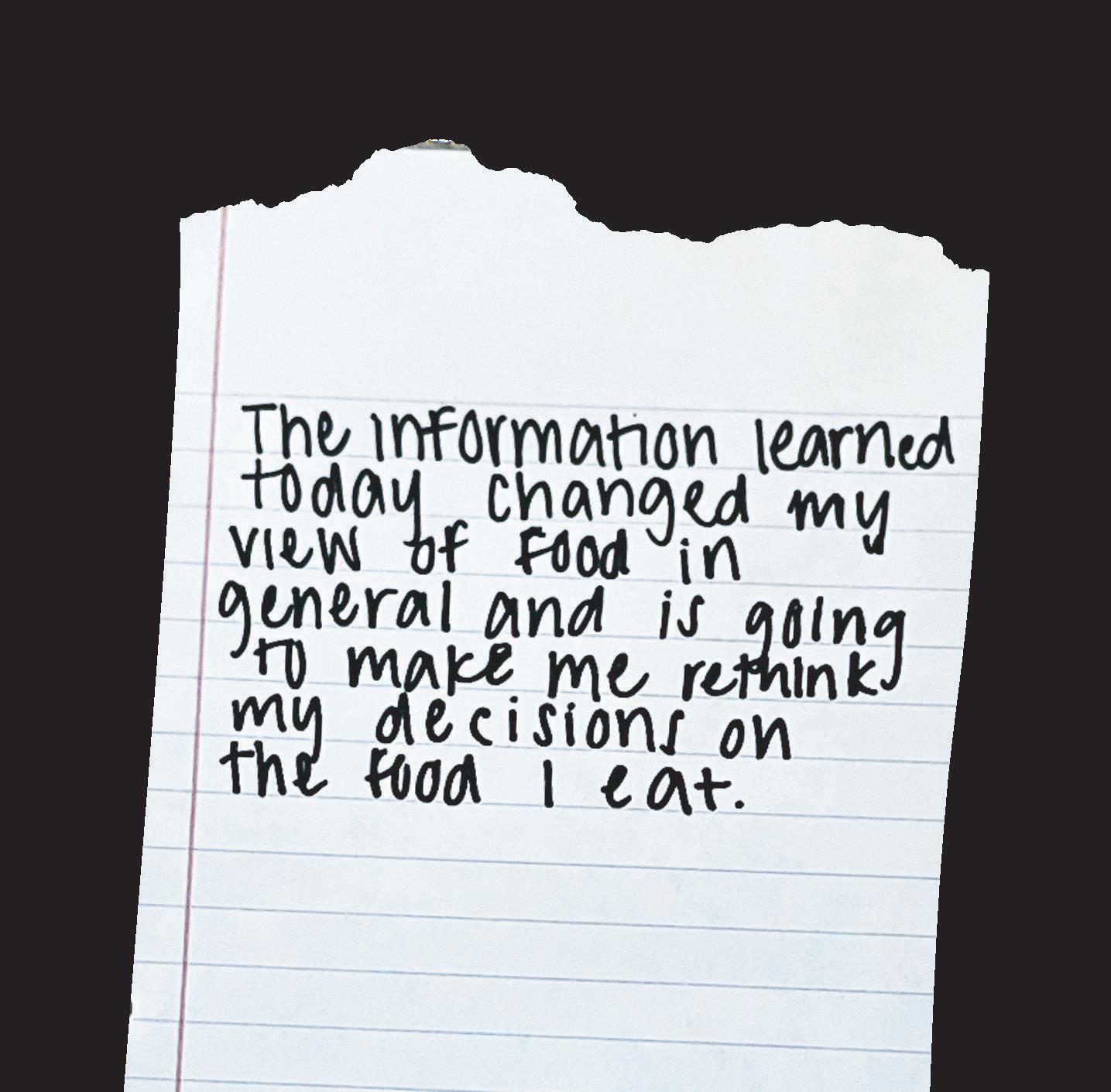

In our program resources, we address the many ways that individual food choices and our current food system contribute to not only human health issues, such as common chronic diseases, but also planetary health issues, such biodiversity loss and climate change. We also encouraging incremental and approachable change. a healthier and more sustainable food system.
DON’T JUST TAKE OUR WORD FOR IT. HEAR FROM REAL TEACHERS USING OUR EDUCATION PACKAGES: visually appealing, and easy for the students to be able to access if they want further informa -
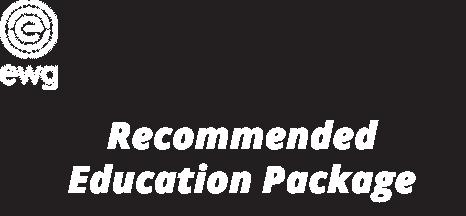

EXPLORE ALL ECP OFFERINGS IN OUR INNOVATIVE VIDEO LIBRARY! Our Carbon Foodprint
“I really love your videos, and I have incorporated them into my face-to-face and online



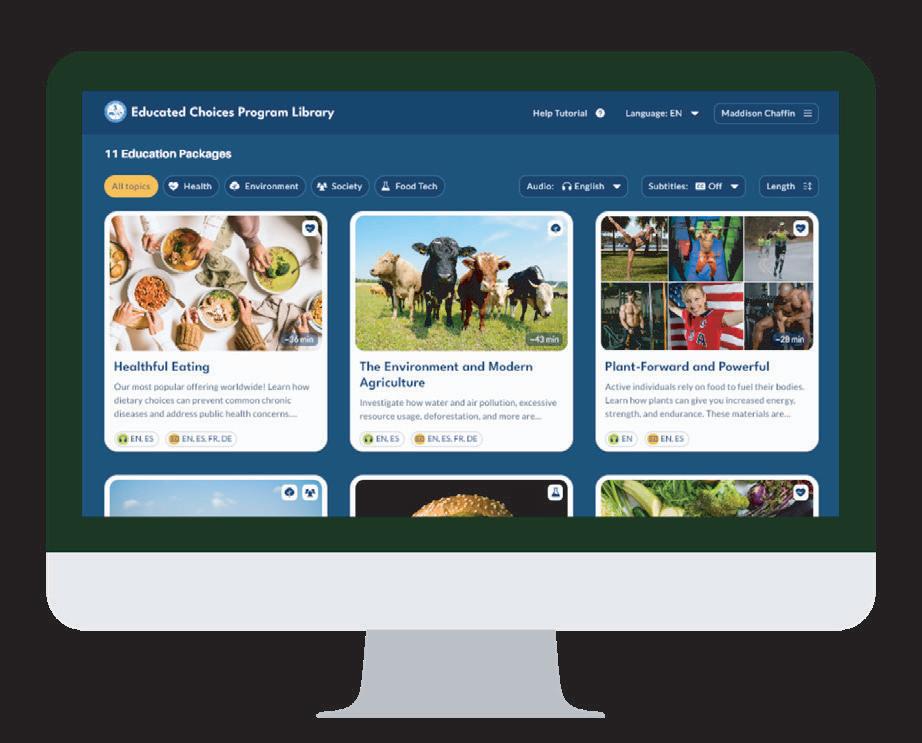
5 TIPS
AN
As a speech language pathologist (SLP), I am an expert in communication disorders in children. My 15 years of experience has spanned from early intervention with our youngest communicators through public education with elementary and secondary students.
In these roles, I have learned that teaching peers, families, educators, and friends to be strong communication partners can be just as important as teaching new skills to the child with the disability.
Communication disabilities can be hard to see, so it’s often easy for others to ignore, interrupt, or even laugh at someone with a disability. People can have disabilities in any of the following areas of speech: articulation (pronunciation of sounds), fluency (stuttering), voice (loudness and quality), language (written or verbal), pragmatics (social and nonverbal communication), or hearing. That’s a lot of areas!
Communication disabilities affect a large portion of our population. In fact, nearly 1 in 12 children ages 3-17 has had a communication-related disorder. That means every elementary classroom in our public school system is bound to have at least one and likely several students with a communication disability. It also means that our general education students are regularly interacting with other students who have these disabilities.
People with communication disabilities can receive help from SLPs, like me, to improve their skills. At school, this comes in the form of services through an Individualized Education Plan (IEP), along with accommodations inside the classroom.
Too often, society puts the burden on the person with a communication disorder to “fix” their disability. But communication is a two-way exchange. Its success depends on both participants. People without disabilities can work hard to be good communication partners because… …it takes two to communicate!
Students with speech and language disorders communicate across a wide variety of modalities. Many use spoken language, but they may be hard to understand because of a stutter or an articulation disorder. Some use nonverbal communication like signs, gestures, picture cues, or an augmentative device. And many young children use a combination of verbal and nonverbal language. As teachers, it’s important to understand how the student communicates so that you’re able to pay close attention and respond appropriately.
Classroom teachers and special education staff can work together to create accommodations within the classroom that will allow students to be successful. Things such as, providing visual schedules, breaking directions into small parts, and giving a student advance warning before calling on them in front of the class are examples of accommodations I often add to IEPs.
Making the classroom inclusive goes beyond implementing accommodations from an IEP, however. Teaching all students to be strong communication partners is one way schools can reduce the burden of communication from the child with a disability. Being a strong communication partner means
showing respect, listening, asking questions, and developing empathy. These are all important and excellent life skills! I believe that teaching students to be strong communicators benefits everyone and fosters an environment of acceptance and inclusivity.
Check out my list of five ways to be a good communication partner. These strategies are simple and designed to be used with a variety of ages, from elementary students to adults. I’ve noticed that most of them align well with the “classroom rules” used in many elementary schools, which is a perfect jumping off point for introducing them to students.
Good communication partners use these skills:
People communicate in all kinds of different ways. It’s important to respect a person’s preferred way of communicating, whether it’s talking, signing, gesturing, using pictures, or using an augmentative alternative communication (AAC) device like a tablet or talker.
You can ask if you’re not sure about the best way to communicate with someone.
Remember to speak in your regular voice and never tease or make fun of someone for being different.
Good listening uses your whole body. Turn your body toward the person who is speaking, try to find a quiet spot, listen carefully, and watch for gestures and pointing as part of the conversation.
While it’s good to face the person who is talking to show you are listening, some people are not comfortable with eye contact. They may show they’re listening without looking you in the eye, and that’s okay.
You may need to wait a little longer when talking with someone with a communication difference. If they use an AAC device, it takes longer to enter the message for the device to speak. Or if they stutter, it can take time to get through a moment of stuttering.
Be patient, let them finish before you respond. You can try counting to ten in your head to help you wait. Please don’t interrupt, speak for them, or tell them to hurry up.
If you don’t understand the person, you can try asking:
a. “Can you say that again?”
b. “Can you say it another way?”
c. Yes/no questions to get more information. Like, “Did it happen at school?”
d. “Can you show me?”
If they don’t understand you, these same strategies will work for them too!
Everyone has different interests, hobbies, likes, and dislikes. Take time to learn about each other. When you find something that you have in common, you can do it together—with or without words! You may make a new friend.
YOU CAN BE A GOOD COMMUNICATION PARTNER!
Use these steps for yourself, share them with your friends, teach them to your students and your own kids. Let’s create a more inclusive space for all our children.
LAURA ELIZABETH BAUKOL,MA,
CCC-SLPis a bilingual speech language pathologist working in public education in the Denver Metro area.
Did you know that May is Speech and Hearing Month in Canada?
It’s also National SpeechLanguage-Hearing Month in America! These observances are meant to raise awareness about communication health and are also a great time to start practicing the skills outlined in this article.
For additional details and resources, visit:
• Speech and Hearing Month
• National Speech-LanguageHearing Month

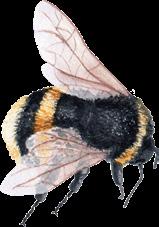

Introducing our newest video series all about books on Diversity and Inclusion!
Featuring an incredible collection of Canadian titles, here you’ll find book recommendations from educators and librarians themselves, showcasing valuable teaching resources to help engage young learners.
